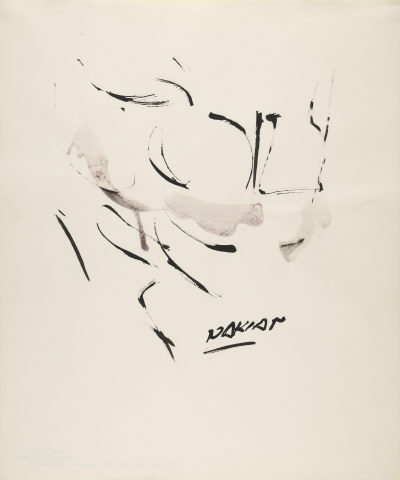
- 1960
- Paper
- Indian ink and Wash
- Inv. DE144
Reuben Nakian
Hecuba Series
The rapid and fluid execution of the drawings from the series Hecuba illustrate the affinities between Reuben Nakian’s work and Abstract Expressionism. However, unlike the latter movement, Nakian does not abandon narrative. The series’ title refers to the Greek tragedy with the same name written by Euripides. Hecuba was, according to Homer’s Iliad, queen of Troy and wife of the king Priam. The plot of Euripides’ tragedy revolves around Hecuba’s vengeance of the death of her sons after the fall of Troy, blinding Polimester and killing his sons in turn. During these year (1960–1962) Nakian also worked on this subject in a monumental sculpture also entitled Hecuba, bronze versions of which exist in the Cincinnati Art Museum and the Stamford Center for the Arts.
The drawings were donated to the CAM on occasion of the acquisition of the sculptures Satyricon I (1981) and Voyage to Crete (1982). While two decades separate the execution of the Hecuba drawings from the two sculptures, it should be noted that, during these last years of Nakian’s life, he used to get back often to his older drawings, which he had accumulated during more than two decades of intensive drawing. The artist commented on this process in an 1981 interview by Avis Berman, which the Smithsonian Institute has made available on-line.
When I want to make to make something new, I go through all of my old drawings in the last twenty-five years, and all the drawings were made for ideas. They weren’t made for drawings. … It’s concept, you know. Motifs … So [when I make something] I go looking at what to do … through my old drawings. I don’t have to sit down and think or make any new compositions. You know, I have a drawing. …
… So it paid off. All these old drawings. I used to sit down at night when I was bored and didn’t know what to do, I’d sit down, made a drawing, and I saved them. … Because making a composition isn’t easy. Even if you have an idea, you have to redraw, redraw it to make the composition. I don’t have to, because the compositions, they’re all solid… So when I want something, I just go through them. And then some drawings, I used to have, I didn’t think much of them, I’ll look at it now and say, “Wait! Hey, this is it!” You know, some drawings have a flavor that you didn’t recognize. So I look at some of these that I used to pass by. When I really look at them and say, “Hey, this is great for…” You know, for this and that, so I use it.
GV
May 2013
| Type | Value | Unit | Section |
| Width | 35,4 | cm | |
| Height | 42,5 | cm |
| Type | signature |
| Type | title |
| Type | date |
| Type | A definir |